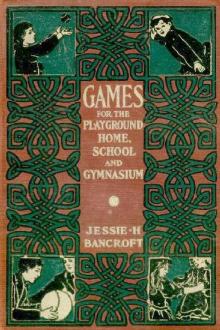Games for the Playground, Home, School and Gymnasium by Jessie Hubbell Bancroft (top novels of all time .txt) 📕

- Author: Jessie Hubbell Bancroft
- Performer: -
Book online «Games for the Playground, Home, School and Gymnasium by Jessie Hubbell Bancroft (top novels of all time .txt) 📕». Author Jessie Hubbell Bancroft
If desired, the slips may be put in a hat or box, the players drawing without looking in. This method is quite suitable for parlor games, where it is much used.
TOSS-UP.—The toss-up is a very simple and popular method of choosing players. It consists in tossing a coin in the air and allowing it to land on the ground, to see which side will fall uppermost, each player having previously chosen a side, or, in other words, taken his chance on that side landing upward. Generally a coin is used, but a stone will do as a substitute, one side being marked. Shells may also be used, the throw to be determined by the light or dark side or the convex or concave side falling upward. The method of tossing is the same for any of these articles. One player tosses the coin in the air, the players having chosen "heads" or "tails"; the side of the coin having the date on it is called "heads," the other side "tails." The side wins which falls uppermost. If a coin or shell does not lie flat on the ground, but rests edgewise, the toss does not count. When this method is used by a group of players, each player is considered out who makes a lucky guess. Any player who guesses the wrong side takes the next turn for tossing the coin. Sometimes it is required that the choice (of heads or tails) shall be made while the coin is in the air, probably to avoid any juggling on the part of the tosser.
RACING; LAST OVER; ETC.—A popular method of determining who shall be "It" for a game is for the players to race to a certain point, the last one to reach it being "It." Or one of a group of players deciding on a game may say "Last over the fence!" when all climb or vault over a fence, the last one over being "It." In the gymnasium this method is sometimes used when the players are grouped in the center of the floor. Upon hearing the shout "Last over!" they all scatter and jump over any available piece of apparatus, bars, horse, etc., the last one to vault being "It."
The Wabanaki Indians use an interesting method, combining counting-out and racing. The players being gathered in a group, each player puts out two fingers, resting them on the ground, a stone, or any convenient place. A counting-out rhyme is then used, one finger being touched for each accent. A finger is doubled under whenever a verse ends on it, until only three fingers are left. The owners, whether they be two or three players, immediately start on a run, the counter chasing them. The one caught is "It."
Some games have each their own distinctive method of choosing players, as in Duck on a Rock. These methods are described with the games wherever they have been obtainable.
CHOOSING SIDES.—For many games the players are divided into two opposing groups or teams. When there is no special leader or captain for each group, some of the above methods of counting-out or choosing are used for assigning players to one side or the other. In most games, however, where there are opposing groups, a captain or leader is first selected. This part sometimes goes to the person who first shouts for it, but it is more usual for the players to choose captains, as special qualities are generally needed in persons in that position, and even young children are glad to place themselves under strong leadership. Captains or leaders, however, may be chosen by any of the previously mentioned methods, or they may be selected by a teacher or leader.
Two captains or leaders having been chosen, each chooses his own players, the choice being made alternately one at a time, the first captain selected generally having first choice. A good captain will select his players for the playing qualities needed in the particular game to be played. These qualities will vary in different games, and different players may be chosen for excellence in one particular direction, such as swift running, agile dodging, boldness in giving dares and taking risks; in ball games, skill in catching or throwing, or other forms of play; and in all games, the ability to "play fair," and to coöperate generously and with good temper. A player may be unskillful, and yet very valuable as a general helper if he possesses the qualities for coöperation. The unpopular player is nearly always a selfish person, one who disregards rules or tries to win unfairly. Aside from the general contempt engendered by such qualities, a player having them is undesirable because he gets his side into disputes or runs a greater risk of increasing the opponent's score with fouls.
MISCELLANEOUS ACTIVE GAMES MISCELLANEOUS ACTIVE GAMES10 to 60 or more players.
Playground; gymnasium; schoolroom.
The players are divided into two or more groups of like numbers which compete against each other. The different groups line up in single file behind a starting line drawn on the ground. Directly in front of each team, at the opposite end of the running space (which should be from twenty to fifty feet long), are drawn two circles, each three feet in diameter, and placed side by side, with rims touching. In one of the circles of each pair three Indian clubs are placed.
On a signal, number one of each file runs forward and with one hand only, changes the clubs from one circle to the other. Each club must be made to stand, and none must touch the outline of the circle. As soon as each player finishes this, he runs back to his file, touches the next player on the hand, and passes off, back of the line. The second player should be waiting for this "touch-off" with toe on the starting line and hand outstretched.
This second player, on receiving the touch-off, runs forward to the circles and changes the clubs from the second ring back to the first, observing the same rules of procedure. Each player, in turn does this, the file winning whose last player is first to dash over the starting line on his return.
This is a very popular game for athletic contests, especially for younger girls. When used in this way, an especially careful observation should be kept for fouls by official judges. One foul is scored against a team for (a) each time a runner starts over the line without the "touch-off"; (b) each time both hands are in play at once in changing the clubs; (c) each club that is not replaced after falling; (d) each club that is left standing anywhere but within the circle for which it was intended. When played thus, according to strict athletic rules, the teams win in the order of finishing plus the smallest score on fouls. Thus, if team A finishes first with six fouls, team B finishes second with four fouls, and team C finishes third with no fouls, team C wins, being given first place, team B second place, and team A third place.
10 to 30 or more players.
Parlor; gymnasium; playground.
One player is blindfolded and stands in the center of a circle with a wand, stick, or cane in his hand. The other players dance around him in circle until he taps three times on the floor with his cane, when they must stand still. The blind man thereupon points his cane at some player, who must take the opposite end of the cane in his hand. The blind man then commands him to make a noise like some animal, such as a cat, dog, cow, sheep, lion, donkey, duck, parrot. From this the blind man tries to guess the name of the player. If the guess be correct, they change places. If wrong, the game is repeated with the same blind man.
The players should try to disguise their natural tones as much as possible when imitating the animals, and much sport may be had through the imitation. Players may also disguise their height, to deceive the blind man, by bending their knees to seem shorter or rising on toes to seem taller.
Where there are thirty or more players, two blind men should be placed in the center.
There is much sport in this game for either children or adults or both together. The author has known it to be the occasion for great merriment under all three circumstances.
ANIMAL CHASE10 to 30 or more players.
Playground; gymnasium.
Two pens are marked off in distant corners of the playground. One player, called the chaser, stands at one side of one of these pens. The other players stand within the pen that is nearest the chaser. All of the players in the pen are named for different animals, there being several players of each kind. Thus there may be a considerable number each of bears, deer, foxes, etc. The chaser calls the name of any animal he chooses as a signal for the players to run. For instance, he may call "Bears!" whereupon all of the players who represent bears must run across to the other pen, the chaser trying to catch them.
Any player caught before reaching the opposite pen changes places with the chaser.
The particular point of difference between this and some other similar chasing games is that the chaser may not know just which of the players in the pen will start out in response to the name of the animal that he calls.
ARROW CHASE8 to 16 players.
Out of doors.
This game is especially adapted to surroundings where a very devious chase may be given, with many opportunities for the runners to go out of sight, double back on their course, etc., as in a village.
The players are divided into two parties. One of these parties, each member having a piece of chalk, starts out on a run over any route chosen by their leader. Every ten feet the runners must chalk a small arrow somewhere along their path, the object of the hunting party being to overtake these runners, discovering their course by the arrows. No attempt is made to get back to a goal, as in many other games of chase.
The hunting party at the starting place counts two thousand to give the runners a full start, and then pursues them. The runners will use all possible finesse in making it difficult to find their arrows, although it is a rule of the game that the arrow must be in plain sight, though not necessarily from the point of view of the course taken. It may be marked on the farther side of a post, stone, etc., or at a considerable height, or near the ground, but never under a ledge or where it might not be seen plainly by any one standing in front of it.
The runners will naturally take a course that will





Comments (0)